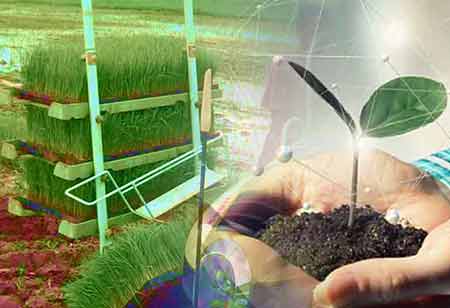Thank you for Subscribing to Agri Business Review Weekly Brief
Biochemical Cycles
This is familiar as the biogeochemical cycle or inorganic-organic cycle.

By
Agri Business Review | Friday, August 12, 2022
Stay ahead of the industry with exclusive feature stories on the top companies, expert insights and the latest news delivered straight to your inbox. Subscribe today.
Since the flow involves living organisms and a series of chemical reactions in the abiotic environments, these are called biogeochemical cycles.
FREMONT, CA: What are biogeochemical cycles?
Around 30 to 40 elements are required for the proper growth and development of living organisms. Most crucial of these are C, H, O, P, K, N, S, Ca, Fe, Mg, B, Zn, Cl, Mo, I, and F. these materials flow from abiotic to biotic components and back to the non-living component again in a more or less cyclic manner.
This is familiar as the biogeochemical cycle or inorganic-organic cycle. The flow of these elements within the ecosystem must be cyclic, with the matter constantly recycled. Since the flow involves living organisms and a series of chemical reactions in the abiotic environments, these are called biogeochemical cycles.
Types of biogeochemical cycles
There are three types of biogeochemical cycles:
1. Hydrologic cycle or water cycle
2. Gaseous cycle:
• Oxygen cycle
• Carbon cycle
• Nitrogen cycle
3. Sedimentary cycle:
• Sulfur cycle
• Phosphorous cycle
Hydrologic or water cycle:
The interchange of water between atmosphere, land, and sea and between living organisms and their environment is accomplished through the water cycle. The water or hydrologic cycle involves evapotranspiration, condensation, precipitation, infiltration, throughflow, runoff, groundwater flow, and evaporation.
The key process is evaporation, as it maintains the humidity of the atmosphere and feeds back the moisture necessary for cloud formation and precipitation. The atmosphere's water attains the earth's surface through precipitation, and from the earth's surface, it reaches the atmosphere via evaporation and transpiration.
The quantity of water available for evaporation is decided by the amount supplied by precipitation and condensation. Between rainfall input and evaporation output, there rests a precarious water balance.
1. Evapotranspiration, 2. Condensation, 3. Precipitation, 4. Infiltration, 5. Throughflow, 6. Runoff, 7. Groundwater flow and 8. Evaporation
Oxygen cycle:
Oxygen is available in the free state of the atmosphere and dissolved in water. It is liberated as a by-product of photosynthesis and is used in respiration by all plants and animals. How plants discharge oxygen in the atmosphere is given below:
When the living organisms respire, it is released, which is employed by green plants as an important raw material for carbohydrates synthesis. Thereby, a simple yet vital O2 cycle is preserved in the ecosystem.
Carbon cycle:
Carbon is the central element of all organic compounds, e.g., carbohydrates, proteins, fats, etc. As energy transfer occurs in consuming and storing carbohydrates and fats, carbon moves to the ecosystem with energy flow. The source of almost all carbon found in living organisms is CO2 found in the free state in the atmosphere and dissolved in the water on the earth.
The amount of CO2 in the air is 0.03%, but this amount is 50 times higher than that of the air in the sea. This CO2 of the sea controls the quantity of CO2 in the air. Carbon makes 40-50% of the dry weight of plants.
Green plants (producers) use CO2 with photosynthesis in the presence of sunlight, and carbohydrate is formed. Afterward, complex fats and polysaccharides are formed in plants used by animals. Carnivores feast on herbivores, and the carbon compounds are absorbed and converted into other forms.
Carbon is released into the atmosphere directly as CO2 in the respiration of both plants and animals. Bacteria and fungi assault the dead remains of plants and animals. They degrade the complicated organic compounds into simple substances, which are then available for other cycles. As coal, gas, limestone, petroleum, and coral reef, part of the organic carbon becomes incorporated into the earth's crust. Carbon from such deposits may be freed after a long term.
Nitrogen cycle:
All elements that plants absorb from the soil are most important for plant growth. This is needed in the greatest quantity. Green plants gain nitrogen from the soil solution in ammonium, nitrate, or nitrite ions.
The most important nitrogen source for green plants is nitrogen, fixed by nitrogen-fixing bacteria. Some nitrogen-fixing bacteria inhabit the root nodules of leguminous and some other plants, and others are free in the soil.
Nitrogen is straight taken from the air by nitrogen-fixing nodule bacteria (rhizobia) or by free-living aerobic bacteria (Azotobacter) or anaerobic soil bacteria (Clostridium). Those bacteria make nitrogen accessible to the plants and add to their growth.
Some blue-green algae, for example, species of Nostoc and Anabaena, also perform nitrogen fixation. Nitrogen is absorbed as nitrate must be decreased to ammonia before being utilized in amino acid and protein synthesis.
Decaying bacteria's collapse of dead tissues releases ammonia from protein and other nitrogenous compounds. For example, Nitrosomonas bacteria oxidize ammonia into nitrites, and other bacteria (Nitrobacter) oxidize nitrite to nitrate (Nitrification). Ammonia is also straightaway converted into free nitrogen by denitrifying bacteria (Denitrification).





